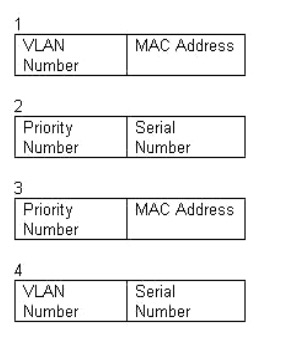In the given exhibit, which combination shows the components of a bridge ID used for Spanning Tree Protocol (STP)?

A. 1
B. 2
C. 3
D. 4
Explanation:
The bridge ID, also known as the switch ID, is used to elect the root bridge in a redundant network topology. The bridge ID has two components:
– Switch’s priority number: Configured as 32768 on Cisco switches by default
– Switch’s Media Access Control (MAC) address: The burnt-in hardware address of the network interface card (NIC)
The switch with the lowest bridge ID is elected as the root bridge. If the same priority number is configured on two or more switches in the network, the switch with the lowest MAC address will become the root.
Bridge Protocol Data Units (BPDUs) communicate the details of the switch with the lowest bridge ID in the network. The election process for the root bridge takes place every time there is a topology change in the network. A topology change may occur due to the failure of a root bridge or the addition of a new switch in the network. The root bridge originates BPDUs every two seconds, which are propagated by other switches throughout the network. BPDUs are used as keepalives between switches. If a switch stops receiving BPDUs from a neighboring switch for ten intervals (20 seconds), it will assume a designated role for the network segment.
The combinations of the remaining options are incorrect because Virtual LAN (VLAN) numbers and serial numbers are not components of a bridge ID. Objective: